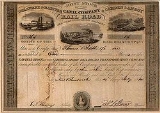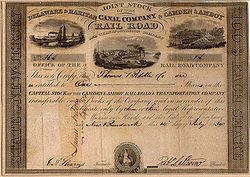
Robert Livingston Stevens
Encyclopedia
Colonel Robert Livingston Stevens (October 18, 1787 – April 20, 1856 Hoboken, New Jersey
) was the son of Colonel John Stevens
. In 1807, the father and son built the Phœnix
, a steamship which became the first steamship to navigate the ocean successfully when she traveled from New York City
to the Delaware River
in 1809. The Phœnix could not operate in the harbor at New York City because Robert Fulton
and his partner Robert Livingston (1746-1813)
, Minister to France, had obtained a monopoly there.
Robert Livingston Stevens applied the wave line, concave waterlines on a steamboat hull, in 1808. He invented other improvements to shipbuilding, and he invented a percussion shell, the rights to which he sold to the government. In 1842, he was commissioned by the government to build the first ironclad warship ever constructed, but he died without ever completing it.
 Robert Stevens was president of the Camden and Amboy Railroad (C&A) in the 1830s and 1840s. When the John Bull
Robert Stevens was president of the Camden and Amboy Railroad (C&A) in the 1830s and 1840s. When the John Bull
steam locomotive
arrived on the C&A property, it was originally named Stevens in his honor. Although his father is occasionally credited with the invention of the flanged T rail for railways, Robert Stevens at 82 is considered to have been the inventor used in the first all-iron rail construction of the Camden & Amboy. Before 1831, the rails of all previous American
railroads were strap iron rails made of wood with a metal strap applied to the wood. One of the two men had traveled to England
to purchase the new rails since there was no rolling mill in the United States
that was capable of producing the rails. The flanged T rail is used by railways of every nation. It replaced the cast-iron edge rails that had been introduced in England in 1789, which were made without flanges; instead, flanges were placed on the wheels. (The flanged T rail was introduced in England
in 1836 by engineer Charles B. Vignoles (1793-1875), therefore the term "Vignoles rails" came into use in Europe
).
He was the brother of John Cox Stevens
and Edwin Augustus Stevens.
Hoboken, New Jersey
Hoboken is a city in Hudson County, New Jersey, United States. As of the 2010 United States Census, the city's population was 50,005. The city is part of the New York metropolitan area and contains Hoboken Terminal, a major transportation hub for the region...
) was the son of Colonel John Stevens
John Stevens (inventor)
Col. John Stevens, III was an American lawyer, engineer and an inventor.-Life and career:Born the son of John Stevens , a prominent New Jersey politician who served as a delegate to the Continental Congress, and Elizabeth Alexander, daughter of New York lawyer and statesman James Alexander. His...
. In 1807, the father and son built the Phœnix
Phoenix (boat)
The Phoenix was a steamboat that was built in 1807 by John Stevens and his son, Robert L. Stevens, at Hoboken, New Jersey.Phoenix was long, wide and deep...
, a steamship which became the first steamship to navigate the ocean successfully when she traveled from New York City
New York City
New York is the most populous city in the United States and the center of the New York Metropolitan Area, one of the most populous metropolitan areas in the world. New York exerts a significant impact upon global commerce, finance, media, art, fashion, research, technology, education, and...
to the Delaware River
Delaware River
The Delaware River is a major river on the Atlantic coast of the United States.A Dutch expedition led by Henry Hudson in 1609 first mapped the river. The river was christened the South River in the New Netherland colony that followed, in contrast to the North River, as the Hudson River was then...
in 1809. The Phœnix could not operate in the harbor at New York City because Robert Fulton
Robert Fulton
Robert Fulton was an American engineer and inventor who is widely credited with developing the first commercially successful steamboat...
and his partner Robert Livingston (1746-1813)
Robert Livingston (1746-1813)
Robert R Livingston was an American lawyer, politician, diplomat from New York, and a Founding Father of the United States. He was known as "The Chancellor," after the office he held for 25 years....
, Minister to France, had obtained a monopoly there.
Robert Livingston Stevens applied the wave line, concave waterlines on a steamboat hull, in 1808. He invented other improvements to shipbuilding, and he invented a percussion shell, the rights to which he sold to the government. In 1842, he was commissioned by the government to build the first ironclad warship ever constructed, but he died without ever completing it.

John Bull (locomotive)
John Bull is a British-built railroad steam locomotive that operated in the United States. It was operated for the first time on September 15, 1831, and it became the oldest operable steam locomotive in the world when the Smithsonian Institution operated it in 1981...
steam locomotive
Steam locomotive
A steam locomotive is a railway locomotive that produces its power through a steam engine. These locomotives are fueled by burning some combustible material, usually coal, wood or oil, to produce steam in a boiler, which drives the steam engine...
arrived on the C&A property, it was originally named Stevens in his honor. Although his father is occasionally credited with the invention of the flanged T rail for railways, Robert Stevens at 82 is considered to have been the inventor used in the first all-iron rail construction of the Camden & Amboy. Before 1831, the rails of all previous American
United States
The United States of America is a federal constitutional republic comprising fifty states and a federal district...
railroads were strap iron rails made of wood with a metal strap applied to the wood. One of the two men had traveled to England
England
England is a country that is part of the United Kingdom. It shares land borders with Scotland to the north and Wales to the west; the Irish Sea is to the north west, the Celtic Sea to the south west, with the North Sea to the east and the English Channel to the south separating it from continental...
to purchase the new rails since there was no rolling mill in the United States
United States
The United States of America is a federal constitutional republic comprising fifty states and a federal district...
that was capable of producing the rails. The flanged T rail is used by railways of every nation. It replaced the cast-iron edge rails that had been introduced in England in 1789, which were made without flanges; instead, flanges were placed on the wheels. (The flanged T rail was introduced in England
England
England is a country that is part of the United Kingdom. It shares land borders with Scotland to the north and Wales to the west; the Irish Sea is to the north west, the Celtic Sea to the south west, with the North Sea to the east and the English Channel to the south separating it from continental...
in 1836 by engineer Charles B. Vignoles (1793-1875), therefore the term "Vignoles rails" came into use in Europe
Europe
Europe is, by convention, one of the world's seven continents. Comprising the westernmost peninsula of Eurasia, Europe is generally 'divided' from Asia to its east by the watershed divides of the Ural and Caucasus Mountains, the Ural River, the Caspian and Black Seas, and the waterways connecting...
).
He was the brother of John Cox Stevens
John Cox Stevens
John Cox Stevens is best known for founding and serving as the first Commodore of the New York Yacht Club as well as being a member of the America syndicate which won the first America's Cup trophy in 1851....
and Edwin Augustus Stevens.

